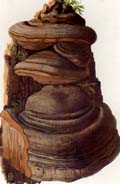
Sessile cap entirely white to buff
Pores concolorous or yellow or pale grey, sometimes darkening in age to grey or even black
Sometimes with moss or algae growing on the cap (coloring it green)
Small Imbricate Polypore SemiTribe
 Key to Gilled Mushrooms Key
Key to Gilled Mushrooms Key Polyporaceae Family
Polyporaceae Family
 Bjerkandera adusta
Bjerkandera adusta Bjerkandera fumosa
Bjerkandera fumosa




